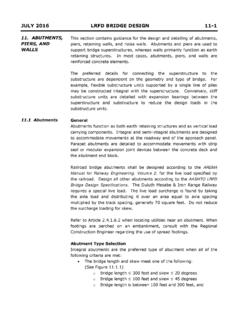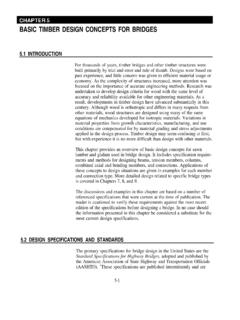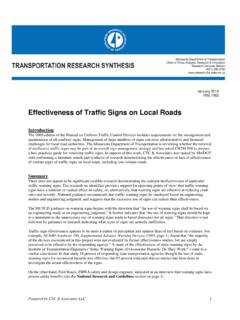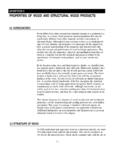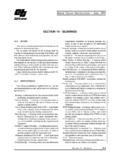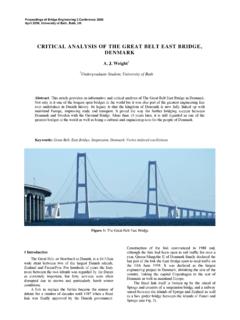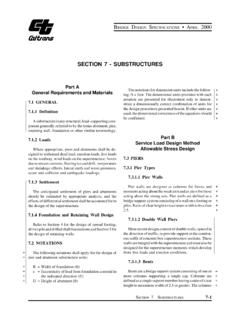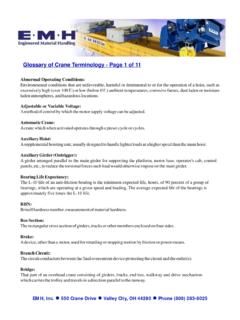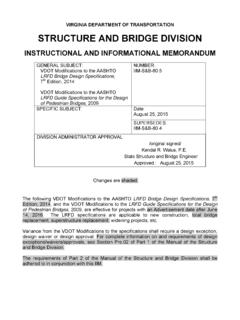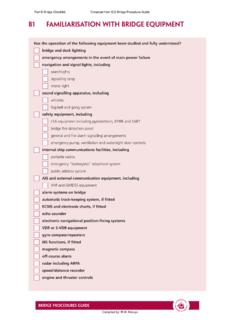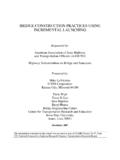Transcription of AUGUST 2016 LRFD BRIDGE DESIGN 3-1
1 AUGUST 2016 lrfd BRIDGE DESIGN 3-1 Load Factors and Combinations [ ] 3. LOADS AND LOAD FACTORS The loads section of the AASHTO lrfd Specifications is greatly expanded over that found in the Standard Specifications. This section will present applicable loads and provide guidance to MnDOT s practice for the application of these loads. The standard load combinations for lrfd DESIGN are presented in lrfd Table Several of the loads have variable load factors ( , P , TG , SE ). The load factors for permanent loads (P ) typically have two values, a maximum value and a minimum value. When analyzing a structure it will often be necessary to use both values. The objective is to envelope the maximum load effects on various elements for DESIGN . A box culvert structure illustrates the use of both values. When determining the moment in the top slab of a culvert, the maximum load factor is used on the vertical earth loads, while the minimum load factor is used on the lateral or horizontal earth loads.
2 The situation reverses when determining the moments in the wall of a culvert. A minimum load factor is used on the vertical earth loads and a maximum value is used on the horizontal earth loads. When assembling load combinations, do not use more than one load factor for any load component. For example, when checking uplift, a load factor of or should be used for the dead load on all spans. Designers should not try to use on the span adjacent to the uplift point and on the next span. Designers must ensure that structures have been checked for adequacy in carrying all appropriate load combinations at all construction stages. For example, check a high parapet abutment for any permissible construction case in addition to the final condition. The abutment may be completely constructed prior to placement of the beams (a case which maximizes the horizontal earth pressure load with a minimum of vertical load) or the abutment could be constructed such that the superstructure is completed prior to backfilling (a case which maximizes vertical load without horizontal earth pressure load).
3 Designers are to investigate both cases. For complex structures, designers are responsible for providing one workable construction sequence in the BRIDGE plan and checking for adequacy at all the construction stages. If the contractor proposes a different construction sequence, the contractor is responsible for confirming structure adequacy at all the construction stages. AUGUST 2016 lrfd BRIDGE DESIGN 3-2 [ ] Load Combinations The load factors and the combination of different load components presented in lrfd Table have been calibrated to produce structures with more uniform reliability than that offered with Standard Specification designs. The Extreme Event I load combinations will rarely control in Minnesota. Note that designs must also consider the load combinations for construction loading. Strength I: Basic load combination used to determine the flexural and shear demands without wind.
4 Strength II: Basic load combination used to determine the flexural and shear demands of a structure subject to a permit vehicle or a special DESIGN vehicle specified by the owner. MnDOT does not typically use special vehicles for DESIGN . See Article for more information. Strength III: Load combination used to determine flexural and shear demands that include a DESIGN wind based on a 3-second gust wind speed of 115 mph. Strength IV: Load combination relating to very high dead load to live load force effect ratios. Use the following modified Strength IV load combination, given in AASHTO lrfd Article : + + Note that Strength IV only applies to superstructures. It does not apply to investigation of construction stages, substructures, retaining walls, or bearings. Strength V: Load combination corresponding to normal vehicular use of the BRIDGE concurrent with a DESIGN wind based on a 3-second gust wind speed of 80 mph.
5 Extreme Event I: Load combination including earthquake effects. Earthquake analysis is typically not performed. Extreme Event II: Load combination corresponding to ice loads, collision loads, and certain hydraulic events with a reduced vehicular live load. This combination is used for barrier DESIGN , deck overhang DESIGN , and pier DESIGN per the pier protection policy found elsewhere in this manual. AUGUST 2016 lrfd BRIDGE DESIGN 3-3 [ ] Service I: Load combination used for the DESIGN of many elements. It is used for service load stress checks (prestressed concrete), deflection checks, crack control checks in reinforced concrete, etc. Service II: Load combination used to check yielding and connections in steel structures. Service III: Load combination used to check outer fiber tension stresses and web principal stresses in prestressed concrete structures. Fatigue I: Load combination used for the DESIGN of structures subject to repetitive live load.
6 It is used for checking infinite load-induced fatigue life. Fatigue II: Load combination used for the DESIGN of structures subject to repetitive live load. It is used for checking finite load-induced fatigue life. Construction: All appropriate load combinations must be considered by designers for construction loads. Use the load factors given in AASHTO lrfd Article for construction loads. AUGUST 2016 lrfd BRIDGE DESIGN 3-4 Load Modifiers [ , , ] Permanent Loads (Dead and Earth) [ ] For most structures, each of the load modifiers will be For a limited number of bridges, load modifiers with values different from need to be used. Table summarizes MnDOT s policy for load modifiers. Note that load modifiers apply only to the strength limit state. For all other limit states, use a value of for all load modifiers. Load modifiers need not be applied to construction load cases.
7 Table Standard MnDOT Load Modifiers Modifier Value Condition Ductility (D ) Steel structures, timber bridges, ductile concrete structures Non-ductile concrete structures Redundancy (R ) * Redundant Non-redundant Importance (I ) ** Temporary Bridges ADT < 500 000,40 ADT500 Major river crossing or ADT > 40,000 on BRIDGE or Mainline interstate on BRIDGE * Beam type superstructures with 4 or more beams per span are considered redundant ** Use Importance load modifier for DESIGN of the superstructure only, except do not apply to deck designs for deck-on-girder type bridges. Use only on new bridges. To reduce the number of load factors considered through the DESIGN process, use a value of ksf for the future wearing surface load and combine with the other component dead loads (DC loads).
8 Also, combine the load due to a concrete wearing course with other DC loads. Apply utility loads as DW loads with the appropriate AASHTO load factor. Table lists unit weights for a number of materials. Designers should note that several of these items differ slightly from the values contained in Section 3 of the lrfd Specifications. AUGUST 2016 lrfd BRIDGE DESIGN 3-5 Live Loads [ ] HL-93 Live Load, LL [ ] Table MnDOT Standard Unit Weights Material Unit Weight (kcf) Bituminous Wearing Course Cast-In-Place Concrete Precast Concrete Precast Box Culvert Compacted Fill on Box Culverts Standard Fill Steel Timber Water HL-93 is the designation for the calibrated DESIGN live load provided in the lrfd Specifications.
9 It should be considered the normal DESIGN load for MnDOT highway structures. For pedestrian bridges, in addition to the pedestrian live load, DESIGN for a maintenance vehicle live load equivalent to an H-5 truck for deck widths from 6 to 10 feet, and an H-10 truck for wider decks. Use of the dynamic load allowance is not required with the maintenance vehicle. Where appropriate, additional live loads should be considered. Additional live loads might include: MnDOT BRIDGE inspection vehicle loads on bridges with large overhangs. MnDOT standard permit trucks on complex BRIDGE types such as curved steel or post-tensioned concrete boxes. Discuss with the BRIDGE Ratings Engineer. Incorporate a live load surcharge into the DESIGN when construction or maintenance equipment will operate adjacent to retaining walls and abutments. Use the DESIGN truck, fatigue truck, DESIGN tandem, truck train and lane loads described in the lrfd Specifications.
10 For simple spans, Tables and at the end of this section list the unfactored moments and shears for HL-93 loading on span lengths between 1 and 200 feet. AUGUST 2016 lrfd BRIDGE DESIGN 3-6 Multiple Presence Factor, MPF [ ] Dynamic Load Allowance, IM [ ] Pedestrian Live Load, PL [ ] Braking Force, BR [ ] [ ] For continuous beam spans, internal studies have led to MnDOT modifications to the double truck live load given in lrfd Article The modifications ensure adequate load ratings for the MnDOT standard permit trucks. In lieu of 90% of the HL-93 double truck stated in the lrfd Specifications, use the following live load for determining negative moments and interior pier reactions: For bridges with longest span 60 feet, apply 125% of the HL-93 double truck with dynamic load allowance plus lane load. For bridges with longest span > 60 feet, apply 110% of the HL-93 double truck with dynamic load allowance plus lane load.

